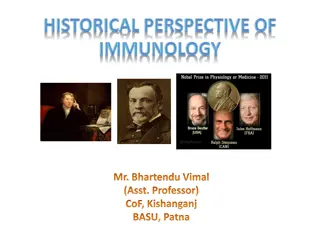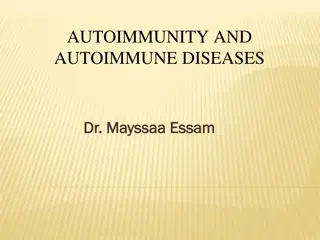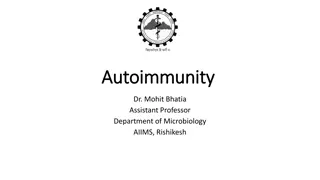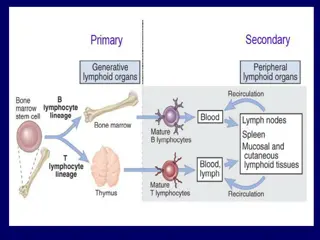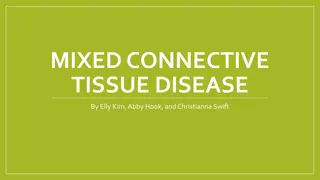Autoimmunity
Autoimmunity is a condition where the body's immune system attacks its own cells, leading to damage. Immunological tolerance is crucial to prevent this, involving central and peripheral mechanisms. Central tolerance eliminates self-reactive cells in thymus and bone marrow, while peripheral tolerance acts as a backup in peripheral tissues. Various mechanisms like ignorance and anergy help maintain tolerance and prevent autoimmune diseases.
Download Presentation

Please find below an Image/Link to download the presentation.
The content on the website is provided AS IS for your information and personal use only. It may not be sold, licensed, or shared on other websites without obtaining consent from the author.If you encounter any issues during the download, it is possible that the publisher has removed the file from their server.
You are allowed to download the files provided on this website for personal or commercial use, subject to the condition that they are used lawfully. All files are the property of their respective owners.
The content on the website is provided AS IS for your information and personal use only. It may not be sold, licensed, or shared on other websites without obtaining consent from the author.
E N D
Presentation Transcript
Autoimmunity Dr. Priyanka Chaturvedi Assistant Professor
Autoimmunity Condition in which the body s own immunologically competent cells or antibodies act against its self-antigens resulting in structural or functional damage. Normally immune system does not react to its own antigens due to a protective mechanism called TOLERANCE. Any breach in tolerance mechanisms predispose to several autoimmune diseases.
Immunological Tolerance: State in which an individual s immune system is not against his own tissue antigens, like in a NORMAL INDIVIDUAL. Mediated by two broad mechanisms: Central tolerance Peripheral tolerance
Central Tolerance Refers to the deletion of self-reactive T and B lymphocytes during their maturation in central lymphoid organs.
Central Tolerance In thymus: During the T cell development in thymus, if any self-antigen is encountered it is processed and presented by thymic antigen presenting cells (APCs) to the developing T cell. Any developing T cell that expresses a receptor for such self- antigen is negatively selected (i.e. deleted by apoptosis).
Central Tolerance In bone marrow: Self antigens are eliminated by Receptor editing - The B cells receptors present over them, so that a different B cell receptor is produced which no longer recognizes the self- antigen. edit the antigen Negative undergo apoptosis. selection- If receptor editing fails, they
Peripheral Tolerance Back-up mechanisms that occur in the peripheral tissues to counteract the self-reactive T cells that escape central tolerance.
Peripheral Tolerance - Mechanisms Ignorance- Self-reactive T cells might never encounter the self-antigen which they recognize.
Peripheral Tolerance - Mechanisms Anergy: Defined as unresponsiveness to antigenic stimulus. The self-reactive T cells interact with the APCs presenting the self antigen, but the co-stimulatory signal is blocked. The B7 molecules on APC bind to CTLA-4 molecules on T cells instead of CD28 molecules.
Peripheral Tolerance Mechanisms Phenotypic skewing: Self-reactive T cells interacting with APCs presented with self-antigens, undergo full activation. Secrete receptors profile. non-pathogenic cytokines and chemokine
Peripheral Tolerance Mechanisms Apoptosis by AICD: Activation-induced cell death Activation of T cells induces upregulation of Fas ligand which subsequently interacts with the death receptor Fas leading to apoptosis.
Peripheral Tolerance Mechanisms Regulatory T cells (Treg cells): Treg cells can down regulate the self-reactive T cells through secreting certain cytokines or killing by direct cell to cell contact.
Peripheral Tolerance Mechanisms Sequestration of self-antigen: Certain self-antigens can evade immune recognition by sequestration in immunologically privileged sites, e.g. corneal proteins, testicular antigens and antigens from brain.
MECHANISMS OF AUTOIMMUNITY Autoimmunity results due to breakdown of one or more of the mechanisms of immunological tolerance.
Breakdown of T Cell Anergy In the presence of tissue necrosis and local inflammation express co-stimulatory molecules (B7) Eg: Multiple sclerosis, rheumatoid arthritis and psoriasis
Failure of AICD Failure of the auto reactive activated T cells to undergo activation induced cell death (AICD) Eg: SLE (systemic lupus erythematosus)
Loss of Treg cells Autoimmunity can result following the loss of regulatory T cell-mediated suppression of self-reactive lymphocytes.
Providing T Cell help to Stimulate Self-reacting B Cells Antibody response to self-antigens occurs only when potentially self-reactive B cells receive help from T cells.
Release of Sequestered Antigens Sequestered antigens -never been exposed to the tolerance mechanisms during development of immune system. Injury to the organs leads to release of such sequestered antigens which are very well capable of mounting an immune response. Spermatozoa and ocular antigens release can cause post vasectomy orchitis and post-traumatic uveitis.
Molecular Mimicry Some (epitopes) with self-antigens. microorganisms share antigenic determinants Immune response against such microbes would produce antibodies that can cross-react with self-antigen. Example: Acute rheumatic fever and multiple sclerosis (molecular mimicry involving T-cell epitopes).
Polyclonal Lymphocyte Activation Polyclonal T cell activation - Superantigens released from microbes (e.g. Staphylococcus aureus), polyclonally activate the T cells. Polyclonal B cell activation can be induced by products of various microbes such as Epstein Barr virus, HIV, etc.
Epitope Spreading Self-peptides released due to persistent inflammation induce tissue damage (as occurs in chronic microbial infection) and are processed and presented by APCs along with microbial peptides. There may occur a spread of T cell recognition to self- epitopes rather than recognizing microbial epitope.
Autoimmune diseases and immune response produced with their clinical manifestations Single Organ or Cell Type Autoimmune Diseases Disease Self-antigen present on Type of immune response & Important features Autoimmune anaemia Autoimmune haemolytic anaemia RBC membrane proteins Auto-antibodies to RBC antigens triggers lysis of RBCs Drug induced haemolytic anaemia Drugs alter the red cell membrane antigens Drugs such as Penicillin interact with RBCs so that the cells become antigenic Pernicious anaemia Intrinsic factor (a membrane-bound protein on gastric parietal cells) Auto-antibodies to intrinsic factor block the uptake of vitamin B 12; leads to megaloblastic anaemia Idiopathic Thrombocytopenic Purpura Platelet membrane proteins (glycoproteins IIb-IIIa or Ib-IX) Auto-antibodies against platelet membrane antigens leads to platelet count (Thrombocytopenia)
Single Organ or Cell Type Autoimmune Diseases Disease Self-antigen present on Type of immune response & Important features Good-Pasture syndrome Renal and lung basement membranes Auto-antibodies bind to basement-membrane antigens on kidney glomeruli and the alveoli of the lungs followed by complement mediated injury leads to Progressive kidney damage haemorrhage and Pulmonary Myasthenia gravis Acetylcholine receptors Blocking type of auto-antibody directed against Ach receptors present on motor nerve endings, leads to progressive weakening of the skeletal muscles Graves disease Thyroid-stimulating hormone (TSH) receptor Anti TSH- auto-antibody (stimulates thyroid follicles, leads to hyperthyroid state)
Single Organ or Cell Type Autoimmune Diseases Disease Self-antigen present on Type of immune response & Important features Hashimoto s thyroiditis Thyroid proteins and cells Auto-antibodies and TDTH cells targeted against thyroid antigen leads to suppression of thyroid gland. Seen in middle aged females Hypothyroid state is produced ( production of thyroid hormones) Post-streptococcal glomerulonephritis [PSGN] Kidney Streptococcal deposited on glomerular basement membrane antigen- antibody complexes are
Systemic Autoimmune Diseases Disease Self-antigen present on Type of immune response & Important features Systemic lupus erythematosus [SLE] Auto-antibodies are produced against various tissue antigens such as DNA, nuclear protein, RBC and platelet membranes. Age & sex- Women (20-40 years of age) are commonly affected; female to male ratio is-10:1. Immune complexes (self Ag- auto Ab) are formed; which are deposited in various organs Major symptoms- Fever, butterfly rash over the cheeks, arthritis, pleurisy, and kidney dysfunction
Systemic Autoimmune Diseases Disease Self-antigen present on Type of immune response & Important features Rheumatoid arthritis A group of auto-antibodies Age & sex- Women (40-60 years of age) against the host IgG affected antibodies are produced Auto-antibodies bind to circulating IgG, called RA factor. forming IgM-IgG complexes that are It is an IgM antibody deposited in the joints. directed against the Fc region of IgG.
Systemic Autoimmune Diseases Disease Self-antigen present on Type of immune response & Important features Sj gren Ribonucleoprotein (RNP) Auto-antibodies to the RNP antigens SS-A syndrome antigens SS-A (Ro) and SS- (Ro) and SS-B (La); leads to immune- B (La) present on salivary mediated destruction of the lacrimal and gland, lacrimal gland, liver, salivary glands resulting in dry eyes kidney, thyroid (keratoconjunctivitis sicca) and dry mouth (xerostomia)
Systemic Autoimmune Diseases Disease Self-antigen present on Type of immune response & Important features Scleroderma Nuclear antigens such as Helper T cell (mainly) and auto-antibody mediated. (Systemic DNA topoisomerase and Excessive fibrosis of the skin, throughout the body Sclerosis) centromere present in heart, Two types- lungs, GIT, kidney, etc 1.Diffuse scleroderma- Auto-antibodies against DNA topoisomerase I (anti-Scl 70) is elevated 2.Limited scleroderma- Anticentromere antibody, characterized by CREST syndrome-calcinosis, Raynaud phenomenon, esophageal dysmotility, sclerodactyly, and telangiectasia
Systemic Autoimmune Diseases Disease Self-antigen present on Type of immune response & Important features Sacroiliac vertebrae Several types- Ankylosing spondylitis Reiter Syndrome Psoriatic Arthritis Spondylitis Inflammatory Disease Reactive arthritis joints & other Common rheumatoid arthritis like features, but differ from it by- Association with HLA-B27 Pathologic changes begin in the ligamentous attachments to the bone rather than in the synovium Involvement of the sacroiliac joints, and/or arthritis in other peripheral joints Absence of RFs (hence the name "seronegative") Auto-Ab and immune complex mediated characteristics- They present as Seronegative Spondyloarthropathies With Bowel
Systemic Autoimmune Diseases Disease Self-antigen present on Type of immune response & Important features Multiple sclerosisBrain (white matter) Self-reactive T cells produce characteristic inflammatory lesions in brain that destroys the myelin sheath of nerve fiber; leads to numerous neurologic dysfunctions
Laboratory Diagnosis of Autoimmune Diseases Autoimmune hemolytic anemia: Diagnosed by - Coombs test - the red cells are incubated with an anti human IgG antiserum. If IgG autoantibodies are present on the red cells, the cells are agglutinated by the antiserum.
Laboratory Diagnosis of Autoimmune Diseases Goodpasture syndrome: Biopsies from patients are stained with fluorescent-labeled anti-IgG and anti-C3b - reveal linear deposits of IgG and C3b along the basement membranes
Laboratory Diagnosis of Autoimmune Diseases SLE: Detection of autoantibodies against various nuclear antigens by indirect immunofluorescence assay (most widely used) and ELISA-based techniques Antinuclear antibody (ANA) Anti-double stranded DNA (dsDNA)
Laboratory Diagnosis of Autoimmune Diseases SLE: Lupus band test- Direct immunofluorescence test - detect deposits of immunoglobulins and complement proteins in the patient's skin.
Laboratory Diagnosis of Autoimmune Diseases Scleroderma: Anti-Scl 70 antibody is raised, detected by indirect immunofluorescence assay Sj gren s syndrome: Diagnosed by detection of SS-A (or anti-Ro) and SS-B (or anti-La) antibodies by indirect immunofluorescence assay
Laboratory Diagnosis of Autoimmune Diseases Rheumatoid arthritis: Diagnosed by RA factor (by latex agglutination test) ACPA (Anti-citrullinated peptide antibodies) Rose-Waaler test to detect RA factor is of historical importance.


